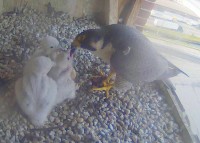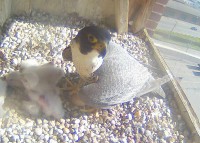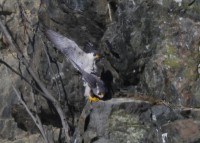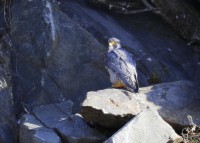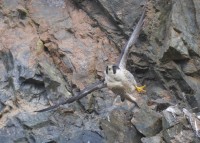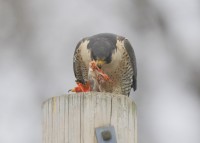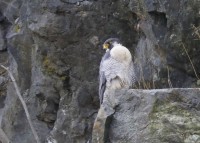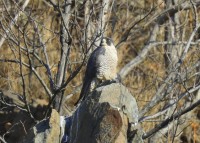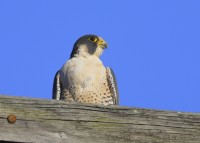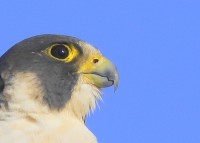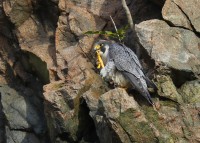Lawrence Peregrines: Day 41/42
June 15, 2019 in Near the Clock Tower
The remaining two Peregrines started off the day under fair skies, bright sun, Sw wind at 5MPH, and temp at 59F. The day ahead calls for mostly sunny, with a high near 83. Southwest wind 6 to 13 mph, with gusts as high as 28 mph. Tonight, a chance of showers, mainly after 3am. Increasing clouds, with a low around 62. Southwest wind 7 to 10 mph, with gusts as high as 22 mph.
 Many have asked, how do the chicks know when to fledge and make first flight? What prompts the final push to launch out into the world forms he nest box? From what researchers have observed over the years, there is likely little particular action by the parent peregrines to induce their young to fly. The adults may reduce the food rations at this time, for the young are quite fat. Generally, the chicks fly when they are ready and moved by their own instinct. The first flight can be quite strong, but when it lands on a nearby perch, it may remain for many hours. Food calls are exchanged, and the parent keeps close tabs from nearby. For a chick that has survived a fall from the nest, the adults will find, feed, and protect the chick until it is ready to fly away.
Many have asked, how do the chicks know when to fledge and make first flight? What prompts the final push to launch out into the world forms he nest box? From what researchers have observed over the years, there is likely little particular action by the parent peregrines to induce their young to fly. The adults may reduce the food rations at this time, for the young are quite fat. Generally, the chicks fly when they are ready and moved by their own instinct. The first flight can be quite strong, but when it lands on a nearby perch, it may remain for many hours. Food calls are exchanged, and the parent keeps close tabs from nearby. For a chick that has survived a fall from the nest, the adults will find, feed, and protect the chick until it is ready to fly away.
Literature cited:
Ratcliffe, D. 1993. The Peregrine Falcon. 2nd ed. Carlton, England: T. and A. D. Poyser.
